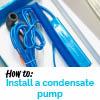Domestic Air conditioning and the use of Condensate Pumps.
Water leaking domestic air conditioning units are number two on the list of call out issues reported for AC breakdowns. This happens directly after an air conditioning install due to the incorrect fitting or years later through lack of air conditioning servicing. Retro fit residential air conditioning units will 9 times out of 10 require a condensate pump. This is because it’s unlikely a gravity drain feed will be available at this stage. Even the best home air conditioning contractors in London will find they cannot avoid the use of a condensate pump system.The Aspen mini aqua pump is a good choice of condensate pump for wall mounted air conditioning split systems. This condensate pump is also extremely flexible across applications, including bespoke wine cellar cooling systems, with its good flow rate and slim pump body.
What’s in the box
- Pump
- Reservoir
- Rubber hose connections
- Suction tubing
- Power cable with cut out contacts
Watch the full installation video here!
The video uses a wall mounted Daikin split air conditioning heat pump system. Choose the location where the pump reservoir best fits. Additionally, ensure the pump reservoir is mounted in the correct orientation for when the unit is wall mounted. Connect the drain outlet of the a/c unit to the reservoir using the large blue rubber hosing in the box. Also, ensure to secure all connections with the white cable ties that came in the kit. Next, find the best location within the unit to conceal the condensate pump. This should be fitted within the revel in the back of the Domestic Air Conditioning Unit with the pipe and cables. The condensate pump should be fitted with the outlet direction facing the direction the waste water should be pumped. The direction of the water flow is marked on the pump with directional arrows. The pump comes with a clear rubber drain hosing which should be installed in two places:
1. Between the low level reservoir outlet and pump inlet.
2. The reservoir has a small stub on the top for over flow drainage.
Connecting the drainage waste hose
Connect the waste water hose to the white nipple connection on the outlet side of the pump. Use a 1/4in internally braided drain hose so you reduce the chance of a blockage through a crushed soft drain hose. A Garden is hose is an example of the type of hosing that can be blocked though the hose collapsing and stopping water flow. Run the braided hose away to your mains waste outlet.
DO NOT CONNECT TO SEWAGE WASTE PIPES
Be sure that you connect to “grey water" waste outlets or directly to outside rain water drains with your braided hose water outlet. Also, connecting to sewage outlets could mean Sewage vapour finds its way back to the condensate pump and gets drawn in the unit.
Powering up the pump
The power for the pump can come directly from the domestic air conditioning indoor unit in this case. It can also have its own separate power supply feed from a local ring mains. (Plug sockets) The power supply should be taken from the air conditioning units interconnecting cable, via a fused spur. The pump comes with high water flow contacts, that open or close in the event the float magnet in the reservoir goes into its highest position. Therefore, simply run your unit communications cable through these contacts. When there is a pump failure and the float reservoir goes and stays at the highest point, the internal contacts will break. Furthermore, this will in turn break your unit comms feed and stop all cooling. Additionally, the unit will show a comms error, whilst stopping its ability to create water and prevent flooding. Therefore, its essential to use these contacts to prevent future flooding and damage. The contacts can also be used to send power to a fault lamp as a warning indicator of a pump failure.
Follow the video in the YouTube channel playlist for a step by guide on how to best carry the wiring process out.

